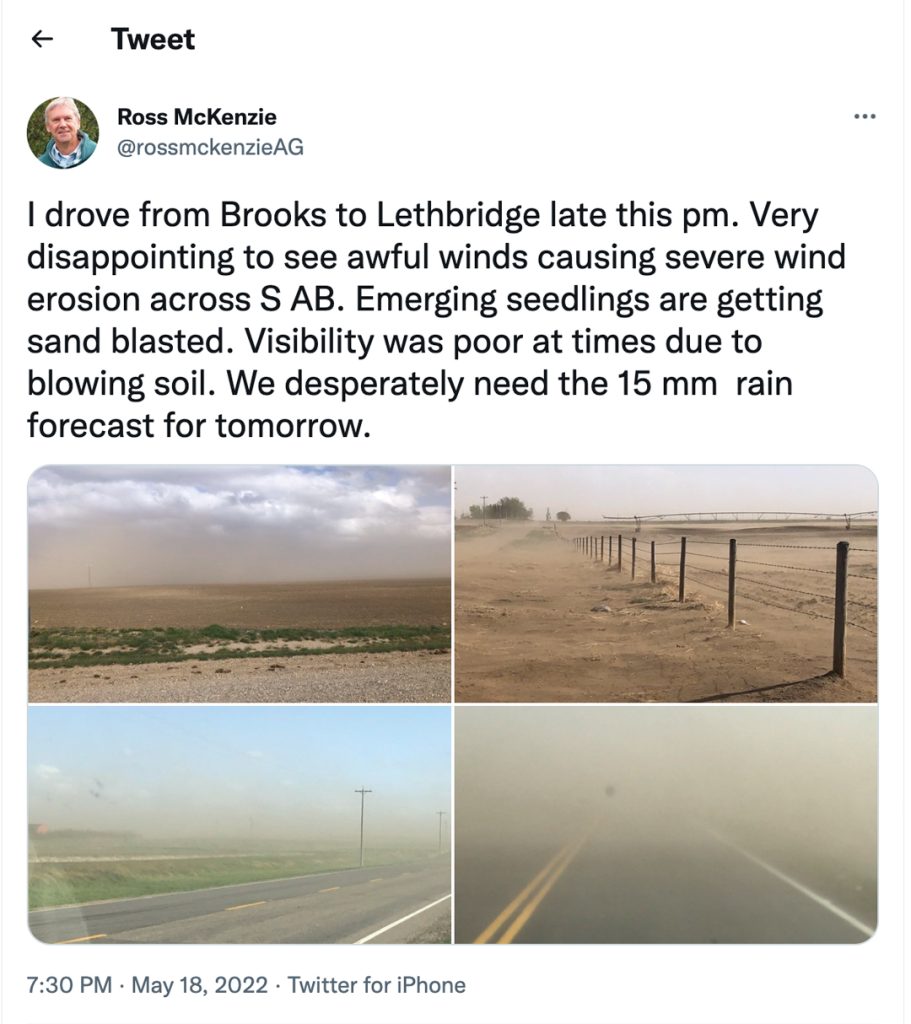A DIRTY SHAME
BY MELANIE EPP • ABOVE PHOTO COURTESY OF ROSS MCKENZIE
On a drive from Brooks to Lethbridge in mid-May, retired provincial agronomy researcher Ross McKenzie was literally stopped in his tracks by dust clouds. Carried by high winds across drought-stricken fields, the dirt was so thick it obscured the road ahead. Disappointed, he snapped a few photos and posted them on Twitter with a desperate plea for rain. McKenzie isn’t alone in his observations. Across the province, but especially in southern Alberta, farmers have noticed the return of this agricultural scourge once thought resolved.
EROSION PAST AND PRESENT
Though not nearly as extreme, the images McKenzie posted were alarmingly reminiscent of those taken during the dust bowl of the 1930s. At that time, the combination of severe drought and high winds swept massive dust clouds across 100 million acres of the Great Plains of North America. The Dirty Thirties ended with tens of thousands homeless and poverty stricken.
A lot has changed since that time. Most Prairie farmers have adopted no-till or minimum-till practices. The use of chemical weed control has allowed them to maintain ground cover yet control weeds. The practices have worked so well soil erosion largely faded as an agronomic concern, until recently.
Ironically, it was National Soil Conservation Week when McKenzie really started to notice the rise in wind erosion on both irrigated and dryland farms. “It just seemed like the entire country was blowing,” said McKenzie, whose main focus at the provincial government was soil and crop research. “The past two growing seasons were very dry with limited crop production. Further, the past two winters were very dry, very windy with very low snow cover,” said Ross. “Fields with limited protective crop residue were increasingly affected by reoccurring winds. Fields that were tilled in the fall or early spring before seeding were subject to more severe wind erosion.”
Soil erosion can be an expensive problem. Healthy soil is essential for healthy plant growth, but it also adds resilience in times of drought, flood and fire, and it plays an integral role in regulating Earth’s climate. To quantify the cost of topsoil lost to wind erosion is no easy task. The cost of wind erosion, said McKenzie, is often expressed in terms of reduced yield potential or the cost of inputs required to replace lost nutrients, both of which are difficult to estimate. Unfortunately, there is very little information available on the quality and value of topsoil that becomes airborne and lost.

In 1987, Agriculture and Agri-Food Canada (AAFC) soil scientist Johan Dormaar determined the organic carbon content of eroded soil material. Using the results of Dormaar’s research, McKenzie estimated the replacement value of the organic matter and total nitrogen, phosphorus and potassium lost in the top five centimetres of a long-term, continuously cropped dark brown soil. In 2013, that number was $7,606 per acre.
According to McKenzie, Dormaar’s research was representative of soil types and cropping conditions across southern Alberta. Using the number above, McKenzie said the approximate value of five centimetres of topsoil on a 5,000-acre farm would have been $38 million. “This is a staggering value,” he added. “Further, this is in 2013 dollars and fertilizer value. In 2022, the value would be approximately double.”
Ken Coles is executive director of Farming Smarter, a non-profit agronomic advisory organization in Lethbridge. He has done similar calculations that use land value. “In southern Alberta, the irrigation land values are so bloody high, you could just take the current land value and divide it by your topsoil,” he said. “If you lose all of your six inches of topsoil, it’s not productive land. Who’s going to want to buy it?”
Like McKenzie, Coles is passionate about soil health. Farming Smarter places much of its focus on applied research with the aim to address pressing farm issues. Recently, the group secured $150,000 from RBC to evaluate the use of fall-seeded cover crops and strip tillage to address erosion on irrigated land, particularly acres planted with potatoes, dry beans and sugar beet.
But Coles believes more needs to be done. “Research alone isn’t going to solve the problem,” he said. The problem is partly cultural, especially on irrigated acres where tillage is still widely accepted. He added more equipment development needs to be done, and manufacturers need to offer implements that can seed through bigger crops and higher residue.
To actively reduce the risk of soil erosion, stop fall tillage altogether, advised Coles. Create a plan to deal with high-risk areas, and incorporate strip tillage where possible. He also advises farmers to adopt cover crops to protect soil where leaving stubble behind isn’t possible.

Monica Klaas, contract agronomist with the Western Winter Wheat Initiative, would also like to see the adoption of cover crops and more acres seeded to winter wheat. The aim of the project, initiated by Ducks Unlimited Canada (DUC), is to support, educate and equip western Canadian farmers in the production of winter wheat.
Winter wheat has high yield potential. Klaas points to Statistics Canada yield data that suggests a range of between 15 and 40 per cent higher than Canadian Western Red Spring wheat. It also negates seeding problems when spring is late or wet, and because it matures earlier, planting winter wheat spreads harvest operations out and reduces the potential for grade losses due to early frost. Perhaps most importantly, though, winter wheat provides soil cover during the fall and winter, thereby reducing the potential for soil loss due to water and wind.
DUC is involved because winter wheat also makes great habitat for migratory waterfowl. “When the birds are migrating in the spring, the fields are seeded and it provides good nesting habitat versus a spring cereal where the seeding operation in the spring may disturb the nest,” said Klaas. Once disturbed, the pintail duck will not renest in that year. “And that presents a huge population issue.”
Where there are ducks there is often water, another source of soil erosion. Tonya Lwiwski is a riparian specialist with the Alberta Riparian Habitat Management Society, better known as Cows and Fish. In an erosion webinar presented in mid-March, she advised viewers on how to protect riparian areas such as streambanks and slow, naturally occurring water erosion. She understands why farmers express frustration over the presence on their land of these green zones that surround waterbodies. They’re inconvenient to work around, especially with a combine, and they can be dangerous for livestock.
There are many benefits to retaining healthy riparian areas, though. They capture and store water, which helps to recharge groundwater reserves. They also trap and store sediments, which, with sufficient vegetation, protects banks and shorelines from erosion and provide habitat for fish and wildlife. From the farmer’s perspective, perhaps their most important benefit is how such areas slow the impact of snowmelt and heavy rain. Without adequate vegetation, runoff can move overland or create gullies, channels and slumping along watercourses.
Cows and Fish circulates a factsheet that lists the plant species best suited to these buffer zones. Willows and sedges, for example, have deep, binding roots. “If you have vegetation, don’t remove it,” said Lwiwski. “And if you have the capacity to help it out by putting in perennial cover as a buffer, that will greatly help riparian health.”
SHORT-TERM SOLUTIONS
Perhaps no one is more familiar with erosion issues in Western Canada than retired federal soil conservation researcher Frank Larney. “And then erosion kind of disappeared off the radar,” he said. “Everybody thought they’d got it sorted, but now it’s coming back.”
Most erosion in Alberta has to do with the surface cover or the lack thereof, said Larney. This is why irrigated land sees more erosion than dryland. “If 30 per cent of your soil surface is covered by residue, wind erosion risk is lowered,” he said. “But once you drop below 30 per cent, your risk increases dramatically.”
One of the factors that makes conservation tillage possible is the use of herbicides for weed control. Conservation tillage really took off in the early 1990s in concurrence with the introduction and affordability of RoundUp. StatCan numbers support this claim. In 1991, 73 per cent of seeded acres in Alberta were under tillage practices that incorporated most crop residue into the soil. By 2016, that number had nearly inversed itself, with only three per cent under tillage while 69 per cent of seeded acres were under no-till production.
“RoundUp is part and parcel of conservation tillage, and has been since its inception,” said Larney. “If you pull RoundUp out of the system, guys may have to go back to mechanical weed control and that wouldn’t be good.”
While farmers have adopted no-till and minimum-till practices across much of the Prairies, on a drive from Lethbridge to Edmonton in 2019, Larney was surprised to see obvious renewed interest in tillage. “I couldn’t believe how bare the surface was due to vertical tillage,” he said.
In wetter years, vertical tillage makes sense because it helps deal with heavy residue. But in dry years, it just leaves fields vulnerable. Providing cover, even with the availability of RoundUp, isn’t always possible. Under drought conditions, crops fail, and conditions come harvest aren’t always ideal for the establishment of cover crops.
There are emergency options to help protect soil in the event of high winds, said Larney.
Tillage with a deep ripper can provide some protection. Deep rippers bring large clods of earth to the soil surface and create a rough landscape that’s more difficult to erode. “The wind loves a flat surface and small aggregates,” said Larney. As well, spreading manure creates a protective carpet that temporarily keeps soil in place.
ONE-TIME AMENDMENTS
Should soil erosion occur, there are also several “treatments” that can repair the damage. In 1990, Larney began a study to measure the impacts of three one-time treatments. The study remains ongoing, and AAFC research scientist Charles Geddes and biologist Brendan Alexander are evaluating its three decades of yield data.
Larney conducted the study in 1990 to understand how various rates of soil erosion and their one-time amendments impacted yield in subsequent years. To do this, he simulated erosion by the removal of five, 10, 15 and 20 centimetres of topsoil from several plots. Leaving one plot as the untreated control, he then treated the remaining plots with three separate one-time amendments. The study was carried out on irrigated and dryland acreage.
The three amendments included, respectively, the addition of nitrogen and phosphorus to replace lost nutrients, the manual replacement of five centimetres of topsoil, and the application of wet cattle manure. The plots were sown with wheat in subsequent years and yield was calculated at the end of each growing season.
In the first three years, the effects of erosion were much more severe than in subsequent years. Over the first 16 years, yield decreased by two per cent for every centimetre of lost topsoil in the untreated control, on average. “If you’re talking about a very severe erosion event, which would be simulated by the 20 centimetre cut depth rate, that would be essentially 40 per cent yield loss,” said Geddes.
While Larney was interested in the annual productivity rate of one-time amended, eroded soil, Geddes seeks to understand how erosion impacts yield variability and stability. The largest contributor to variability, unsurprisingly, is precipitation, but erosion and amendment treatments do contribute to some of this variability. As cut depth increases, adaptability declines and the risk of yielding below the profitability threshold rises. The more severe the erosion event, the greater the impact the amendments have on long-term productivity.
The first and most obvious observation is that erosion can have a significant impact on wheat yield in southern Alberta, said Geddes. “If you’re considering amending an eroded soil to help restore productivity, what we’re finding is that the best and most consistent amendments are manure, followed by topsoil replacement, followed by the fertilizer,” said Geddes.
“Over time, the impact of those amendments does appear to decline somewhat, and more so in the initial years,” he added. “But, to this day, we can still see the effects of those different amendments on yields overall.”

FARMERS DISH THE DIRT ON SOIL PRACTICES
John Kolk farms 3,000 acres of irrigated land in the Palliser Triangle in southern Alberta, a region famous for low humidity, low moisture and wind. “Most of our soils are lighter soils, so when it dries on top and we don’t get snow cover, we can get fairly significant wind erosion,” he said.
Kolk grows seed canola, dry beans, wheat, barley, flax and peas, sowing with a direct seeder. When he purchased the farm in 2010, he put an erosion reduction action plan in place. Working with Farming Smarter, he has minimized tillage, using it only when incorporating manure, which he applies, in part, to improve aggregate stability. He also experiments with cover crops.
Weed control becomes a greater challenge when adopting these methods, he said. “You win on one side and you lose on the other. You need to put the whole package together. That takes experimentation, willingness to take risks and hopefully a little bit of help from society,” he added. “If we can keep our soils healthier and reduce dust in the air, those are benefits to society as well.”
Brian Slenders works hard to beat soil erosion because he and his brother irrigate their 1,600-acre Scandia property, and in heavy wind events, soil moves. During the drought of 2000-01, Slenders found a fence line and drainage ditch pipeline in his region both buried under almost a metre of topsoil. Though his own land was less affected, he and his brother have since worked to keep precious topsoil in place.
Slenders isn’t alone. In recent years, southern Alberta farmers, particularly those under irrigation, have seen a huge increase in major wind events. In the County of Newell where the brothers’ farm is located, erosion has raised so much alarm that farmers have formed a wind erosion committee. Todd Green, director of agricultural services for the County, heads the committee, and Slenders is a member. The group aims to help landowners find reasonable solutions to minimize soil erosion.
“We know it’s hard to stop soil erosion from occurring when it is going on,” said Green. “But after that wind event is done, there are things that can be put in place to help minimize it going forward.”
If no action is taken, the committee issues a soil conservation notice. So far, the County has issued just two notices. In both cases, compliance wasn’t a problem. “Enforcement is by far the worst part of our job,” said Green.
For the most part, emphasized Slenders, farmers in the region take soil erosion seriously. If you’re not prepared, there is no stopping it once it’s underway, he advised. “You’ve got to get ahead of the game.”







Comments